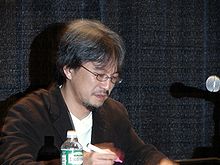Eiji Aonuma
Eiji Aonuma | |
|---|---|
青沼 英二 | |
 Aonuma at the 2007 Game Developers Conference | |
| Born | Eiji Onozuka (小野塚 英二)[1] March 16, 1963[2] Nagano Prefecture, Japan |
| Alma mater | Tokyo National University of Fine Arts and Music |
| Occupation(s) | Video game designer, director, producer |
| Employer | Nintendo (1988–present) |
Eiji Aonuma (Japanese: 青沼 英二(あおぬまえいじ), Hepburn: Aonuma Eiji, born March 16, 1963) is a Japanese video game designer, director and producer, who works for Nintendo as the series producer and manager of The Legend of Zelda.
Early life
Aonuma attended the Tokyo National University of Fine Arts and Music where he majored in design, working on moving mechanical figures. He graduated in 1988.[3]
Career
Nintendo
After graduating, he interviewed at Nintendo. Aonuma met Shigeru Miyamoto during the interview, and showed Miyamoto samples of his college work. His first projects involved graphic design, creating sprites for Nintendo Entertainment System games such as 1991's NES Open Tournament Golf. Aonuma was director of development on 1996's Marvelous: Mouhitotsu no Takarajim for the Super Nintendo Entertainment System.[4]
In a move which Aonuma attributes to his position on the Marvelous team, Miyamoto recruited Aonuma to join the development team for the Zelda series.[4]
He spent several years as a lead designer of The Legend of Zelda series: 1998's The Legend of Zelda: Ocarina of Time and its sequel Majora's Mask, both for the Nintendo 64; and The Wind Waker, the first Zelda game for the GameCube. After The Wind Waker, Aonuma considered moving onto other projects, but was convinced by Shigeru Miyamoto to continue with the Zelda series.[5] He codeveloped The Legend of Zelda: Twilight Princess, the second major Zelda game to be released for the GameCube and a launch game for the Wii. He was voted Designer of the Year for his work on Twilight Princess in Electronic Gaming Monthly's 2006 1Up Network Awards.[5] He then codeveloped a sequel to The Wind Waker for the GameCube, The Legend of Zelda: Phantom Hourglass, followed by another Nintendo DS title, The Legend of Zelda: Spirit Tracks. He codeveloped Link's Crossbow Training, which is the first game to use the Wii Zapper. He has since produced The Legend of Zelda: Skyward Sword for the Wii, The Legend of Zelda: A Link Between Worlds for the Nintendo 3DS, and is producing The Legend of Zelda: Breath of the Wild for the Wii U and Nintendo Switch.[6][7][8]
In November 2016, Aonuma received the Lifetime Achievement Award at the Golden Joystick Awards.[9]
Music
Aonuma plays percussion as a member of a brass band he founded with five others in 1995, known as The Wind Wakers, named after the game of the same name. The band comprises over 70 Nintendo employees who perform four concerts a year.[10][11][12]
Works
References
- ^ "今度のゼルダは「ダンジョンがたいへん」らしい。その1". 「ゼルダの伝説 時のオカリナ」の情報・産地直送!. Hobo Nikkan Itoi Shinbun. 28 November 1998. Retrieved 27 June 2010.
- ^ "ニンドリドットコム〜ゼルダの伝説 夢幻の砂時計 開発スタッフインタビュー〜". NINDORI.com. August 2007.
- ^ https://www.theguardian.com/technology/2009/nov/25/eiji-aonuma-legend-zelda-interview
- ^ a b Szczepaniak, John. "Before They Were Famous". Retro Gamer (35). Imagine Publishing: 77.
- ^ a b Electronic Gaming Monthly, Issue 213, March 2007. Page 79.
- ^ McWhertor, Michael. "The Legend of Zelda: A Link to the Past sequel coming to Nintendo 3DS this holiday". Polygon. Vox Media.
- ^ "IGN: GDC 2004: The History of Zelda". IGN. Ziff Davis. Retrieved October 10, 2014.
- ^ "IGN: Miyamoto and Aonuma on Zelda". IGN. Ziff Davis. Retrieved October 10, 2014.
- ^ Whitehead, Thomas (November 18, 2016). "Eiji Aonuma Wins Golden Joystick Lifetime Achievement Award as Pokémon GO Picks Up Two Gongs". Nintendo Life. Gamer Network. Retrieved November 19, 2016.
- ^ Puha, Thomas; Kennedy, Sam. "1up Profiles Zelda Director Eiji Aonuma". 1up. Retrieved 5 October 2015.
- ^ Hilliard, Kyle. "Zelda Producer Eiji Aonuma Talks Creating Majora's Mask And His Personal Hobbies". Game Informer. Retrieved 5 October 2015.
- ^ Cole, Michael. "GDC 2004 - Eiji Aonuma Zelda Roundtable". Nintendo World Report. Retrieved 5 October 2015.
External links
- Eiji Aonuma at Nintendo Miiverse
- Eiji Aonuma at IMDb
- Eiji Aonuma's profile at MobyGames
